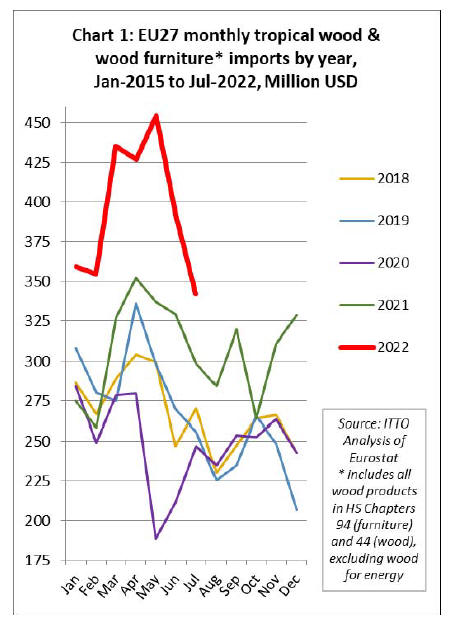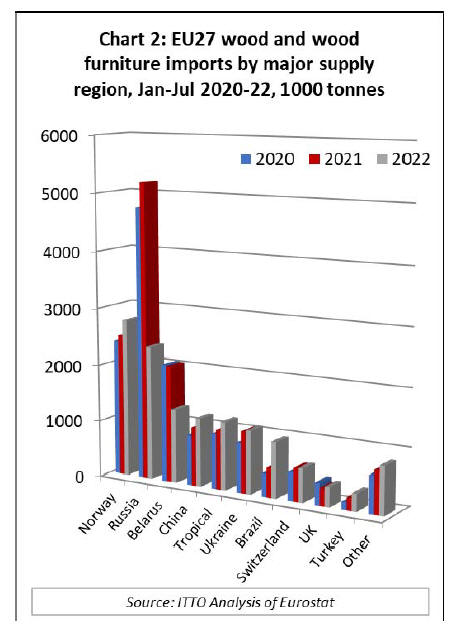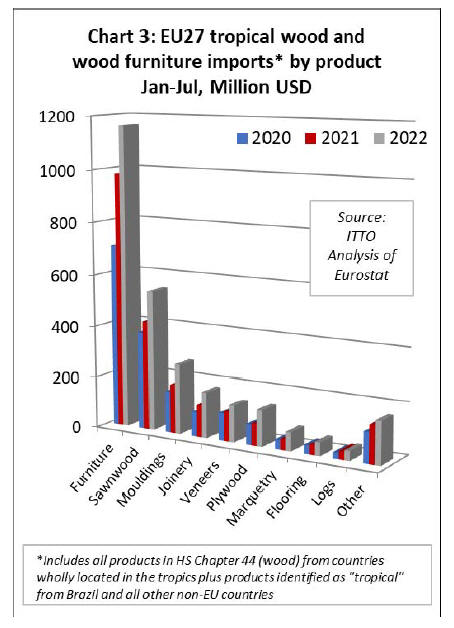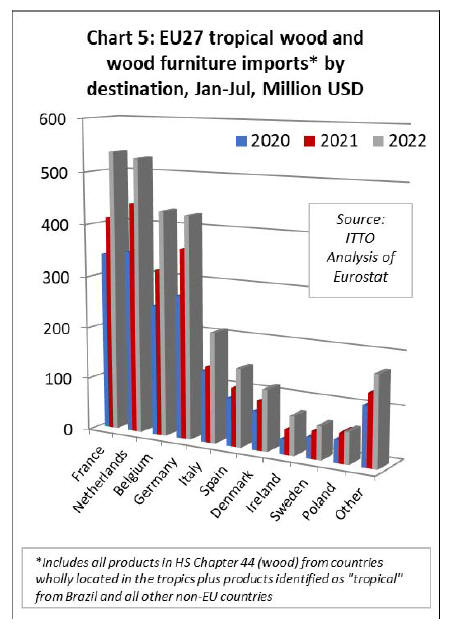|
Report from
Europe
EU27 tropical wood imports come off the boil as
recession fears mount
The most recent EU27 trade data to end July this year
shows that imports of tropical wood and wood furniture
products were still at historically high levels in the early
summer months this year. However, imports were slowing
from the peak reached in May.
Now, as Europe moves into the winter months there are
ominous signs of recession ahead, particularly as the war
in Ukraine is contributing to huge increases in energy
prices and business and consumer confidence is being hit
by expectations of higher interest rates to control inflation.
The level of imports in June and July, while still high
compared to previous years, were also sharply declining in
June and July from the heights reached between March
and May (Chart 1).

In the first seven months of this year, the EU27 imported
tropical wood and wood furniture with a total value of
USD2.76B, a gain of 27% compared to the same period
last year. Part of the gain in EU27 tropical wood product
import value was due to a rise in CIF prices. In quantity
terms, EU imports of tropical wood and wood furniture
products in the first seven months of this year were, at
1,190,200 tonnes, up 14% compared to the same period in
2021.
The high level of imports in the first seven months this
year was driven by the combination of a sharp fall in the
value of the euro against the dollar, continuing high freight
rates, and severe shortages of wood and other materials.
Since the start of this year, the value of the euro has
declined around 15% against the US dollar and is currently
at the lowest level for 20 years. In mid-July, the euro hit
parity with the US currency for the first time since 2002
and fell to a low of 0.95 against the dollar at the end of
September. The euro’s slide underlines the foreboding in
the 19 European countries using the currency as they
struggle with an energy crisis caused by Russia’s war in
Ukraine.
The curtailment of wood supplies from Russia and Belarus
due to the sanctions imposed by the EU following the
invasion of Ukraine in February has opened up new
opportunities in the EU market for some tropical wood
products, notably plywood and decking for which Russian
birch and larch products have been important substitutes.
In the first seven months of this year, tropical products
accounted for 9.2% of the quantity of all wood and wood
furniture products imported into the EU27, which
compares to 6.8% during the same period in both 2021 and
2020.
The gain in tropical wood share is due mainly to a large
reduction in imports from Russia (-55% to 2.34 million
tonnes) and Belarus (-37% to 1.30 million tonnes) during
this period.
After an initial fall in the early months of the war, EU27
imports from Ukraine recovered some ground in the
second quarter and by the end of the first seven months of
this year were, at 1.11 million tonnes, only 3% down on
the same period in 2021 (Chart 2).

While tropical wood has made gains in the EU market this
year, the largest beneficiaries of the opening supply gap
due to the fall in imports from Russia and Belarus have
been non-tropical wood products from Norway (+11% to
2.77 million tonnes), China (+17% to 1.20 million tonnes),
Brazil (+90% to 976,700 tonnes), Turkey (+38% to
304,200 tonnes), Chile (+67% to 66,900 tonnes), and New
Zealand (+24% to 34,800 tonnes).
While not benefitting as much as other supply countries,
there were increases in EU27 imports of most wood
product groups from tropical countries in the first seven
months of this year (Chart 3). For wood furniture, import
value of USD1163M during the January to July period was
18% more than the same period last year, although import
quantity was down 5% at 235,200 tonnes.
For tropical sawnwood, import value of USD543M was
29% up on the same period last year while quantity
increased 25% to 447,600 tonnes. Import value of tropical
mouldings/decking was USD271M in the first seven
months of this year, a gain of 43% compared to the same
period in 2021, while quantity increased 3% to 117,000
tonnes.
There were also large gains in EU27 imports of tropical
joinery products (+43% to USD178M, +29% to 67,000
tonnes), tropical veneer (+24% to USD142M, +25% to
94,800 tonnes), plywood (+66% to USD141M, +30% to
82,200 tonnes), marquetry (+69% to USD73M, +49% to
12,400 tonnes), flooring (+33% to USD51M, +23% to
16,500 tonnes) and logs (+14% to USD37M, +12% to
61,600 tonnes) .

In terms of source countries, EU27 imports of wood and
wood furniture in the first seven months this year were up
significantly compared to the same period last year:
Indonesia (+33% to USD643M, +6% to 162,600 tonnes),
Vietnam (+23% to USD593M, +4% to 138,400 tonnes),
Gabon (+32% to USD179M, +29% to 160,400 tonnes),
Brazil (+60% to USD228M, +27% to 150,200 tonnes),
Cameroon (+19% to USD160M, +21% to 162,200
tonnes),
Republic of Congo (+6% to USD63M, +12% to 68,100
tonnes),
and
Cote d'Ivoire (+15% to USD37M, +7% to 28,700 tonnes).
While import value from Malaysia increased 24% to
USD267M, import quantity was flat at 101,000 tonnes.
Import value from India increased 7% to USD268M but
import volume fell 7% to 63,300 tonnes during the seven
month period (Chart 4).

EU27 import value of tropical wood and wood furniture in
the first seven months this year increased into all the
leading EU destinations for these products, while import
quantity increased into all destinations except Germany.
Trends into the main import destinations were:
France (+30% to USD537M, +8% to 233,100 tonnes);
Netherlands (+19% to USD526M, +9% to 204,800
tonnes);
Belgium (+35% to USD431M, +18% to 287,800 tonnes);
Germany (+17% to USD426M, -1% to 120,100 tonnes);
Italy (+47% to USD211M, +44% to 112,400 tonnes);
Spain (+34% to USD148M, +35% to 62,700 tonnes); and
Denmark (+23% to USD116M, +11% to 28,600 tonnes)

Sharp deterioration in European economic indicators
The latest eurozone economic update by ING Group, the
Dutch multinational banking and financial services
corporation, reports that “after a deceleration in economic
growth over the summer months, eurozone indicators
strongly deteriorated in September, suggesting the start of
a recession. The challenges that the eurozone economy has
been facing over the last few months have not
disappeared. If anything, they have got worse”.
The ING Group particularly highlight the impact of the
war in Ukraine on energy prices in Europe and the effects
of this on the wider economy: “natural gas exports from
Russia to the European Union have been cut further and
the sabotage of the Nord Stream 1 and 2 pipelines has
created some fears regarding the safety of the gas pipelines
from Norway. Unfortunately, according to the latest
weather analyses, the risk of a cold winter has risen”.
With mounting concerns on the supply side, ING Group
“continue to expect very tight natural gas markets over the
winter months, keeping prices at uncomfortably high
levels. Moreover, because of the lack of natural gas
imports from Russia, prices are not likely to fall
significantly in 2023. This will hurt the supply side of the
economy, with a growing number of European companies
reducing production. And while governments have stepped
up their support for households and businesses, we still
believe that consumption will contract. At the same time,
increasingly tight financial conditions are another
headwind for growth”.
ING Group go on to suggest that “while the deceleration
of economic activity seemed to be limited during the
holiday season, the September data now clearly screams
recession”.
They point to the latest figures from the S&P Global
Eurozone Composite Purchasing Managers Index (PMI)
which stood at 48.2 in September, well below the 50
boom-or-bust-level.
According to ING Group “With inventories building on
the back of slowing sales, eurozone manufacturers reduced
their purchases of inputs for the third month in a row.
Consumer confidence fell in September to the lowest level
since the survey started, with households especially
worried about their financial situation over the next 12
months”.
ING Group note that the eurozone inflation rate rose to
10% in September. Energy prices were the main culprit,
but core inflation excluding energy also rose to 4.8%. The
European Central Bank is therefore expected to become
more aggressive in raising interest rates. ING Group are
forecasting a 75bp hike in October, followed by 50bp in
December and 25bp in February 2023, bringing the
deposit rate to 2.25%.
ING Group forecast a small negative GDP growth figure
for the eurozone in the third quarter of 2022 and a deeper
downturn over the winter months. For next year, ING
Group anticipate a 0.8% GDP contraction, after a 2.9%
expansion in 2022.
Being particularly sensitive to changes in mortgage
interest rates - and following a big short-term boost to
activity in the immediate aftermath of the COVID-19
pandemic - the downturn in the eurozone construction
sector is expected to be even larger than in the wider
economy. The S&P Global Eurozone Construction Total
Activity Index was well below the no-change mark of 50.0
for the fifth successive month in September, at 45.3. The
figure for Germany, at 41.8, was particularly low. The
figures for Italy (46.7) and France (49.1) were closer to
neutral territory.
Broken down by sector, the S&P Index showed that
housing activity in the Eurozone during September fell at
the fastest rate since May 2020. The fall in the Index was
less dramatic for civil engineering and commercial
activity, but still below the no-change mark.
New orders placed with eurozone construction companies
declined for the sixth successive month in September and
the rate of contraction quickened for the fifth month
running to the sharpest since May 2020. Data broken
down by country showed that a much a steeper reduction
in Germany drove the overall acceleration, offsetting
softer falls in both France and Italy.
September data revealed a worsening degree of pessimism
among eurozone construction companies regarding the
year-ahead outlook for business activity. Companies were
at their most downbeat since the first COVID-19
lockdown in April 2020, reflecting the growing risk of
recession in the wider economy.
German construction firms were at their most pessimistic
since March 2020, while their French counterparts were
less downbeat than in August and Italian firms were
modestly optimistic.
Commenting on the latest results, Trevor Balchin,
Economics Director at S&P Global Market Intelligence,
said: "September data rounded off a very weak third
quarter for the eurozone construction sector. Outside of the
pandemic, the rate of decline in activity in the third quarter
was the strongest since the fourth quarter of 2014. Activity
fell sharply again in September, with Germany posting a
notably steep rate of contraction. The overall pace of
decline eased due to slower falls in France and Italy,
although this masked a worsening outlook as both new
orders and firms' 12-month expectations sank deeper into
negative territory”.
European Parliament and Council start joint
negotiations on new deforestation law
On 13 September 2022, the European Parliament adopted
its position (the "Parliament Position”) regarding the
Proposal for a Regulation on Deforestation-Free Products
(the “Proposal”), published by the European Commission
on 11 November 2021. The Council of the EU had
adopted its general approach on the Proposal on 28 June
2022 (the “Council Approach”).
The first Trilogue for the regulation was held in the last
week of September. Trilogues are informal tripartite
meetings on legislative proposals between representatives
of the Parliament, the Council and the Commission. Their
purpose is to reach a provisional agreement on a text
acceptable to both the Council and the Parliament.
The EU hope to reach political agreement on the Proposal
before the COP15 on Biodiversity in December in
Montreal. Trilogues are an informal procedure with no
pre-set timeline, but the process typically averages 3 to 6
months.
Once political agreement between the Parliament and
Council has been reached, the agreed text would still need
to be formally endorsed by both legislative bodies, the
timing dependent on political urgency and other factors.
Once adopted, the main obligations imposed by the
Proposal would then apply 12 months (or 18 months as per
the Council Approach) from its entry into force, except for
microenterprises (and for SMEs as per the Parliament
Position) for which it would only apply 24 months after
the entry into force.
The three versions of the law on which the Trilogue
negotiations are based are available as follows:
Commission Proposal of 11 November 2021:
https://environment.ec.europa.eu/document/download/5f1b726e-d7c4-4c51-a75c-3f1ac41eb1f8_en?filename=COM_2021_706_1_EN_ACT_part1_v6.pdf
European Council Approach adopted 28 June 2022:
https://data.consilium.europa.eu/doc/document/ST-10284-2022-INIT/en/pdf
European Parliament Position adopted 13 September
2022:
https://www.europarl.europa.eu/doceo/document/TA-9-2022-0311_EN.pdf
Although the EU institutions are broadly aligned on
overall approach and objectives, the Parliament and the
Council have suggested a number of changes to the
Proposal. The Parliament, in particular, wants an enlarged
scope of application (which would include financial
institutions) and an extended range of penalties. A recent
independent comparison of the three positions by
Linklaters, an international law firm, is available at:
https://sustainablefutures.linklaters.com/post/102hydp/eudeforestation-proposal-next-steps
A new independent analysis of the implications of the law
for the tropical timber trade by Alain Karsenty Fondation
pour la Nature et l’Homme is available:
In French:
https://www.fnh.org/wpcontent/uploads/2022/09/TT-contribution-deforestation.pdf
In English:
https://www.atibt.org/files/upload/news/EU_REGULATION/The_draft_European_regulation_on_imported_deforestation.pdf
Recent timber trade and industry comments on the law
include:
Open Letter of 7 September 2022 from CEI-Bois, EOS,
ETTF and ATIBT:
https://www.ceibois.org/_files/ugd/5b1bdc_9f34319605d844ec8fe606682f90f14d.pdf
Considerations of the European forest-based industries on
the proposal for a regulation on deforestation and forest
degradation adopted by the European Parliament signed by
some of the leading European forest products industry
associations:
https://www.ceibois.org/_files/ugd/5b1bdc_bb2d941402734f90b3883eb1f12387ca.pdf
Independent press commentary on the legislation,
including free access to an on-line event at which
representatives from the commercial food and agriculture
sectors, academics and NGOs discuss some of the wider
implications of the legislation, is available at:
https://www.foodnavigator.com/Article/2022/10/07/do-duediligence-laws-actually-promote-climate-smart-food
https://www.foodnavigator.com/Article/2022/08/25/duediligence-obligations-a-golden-opportunity-for-transparentsupply-chains-or-a-costly-administrative-nightmare
European Parliament wants new FLEGT VPAs with
more partners
There is only passing reference in these various
commentaries on the future role of the existing FLEGT
VPA process and licenses in the prospective EU
deforestation-free regulatory framework. More insight is
gained from review of the three versions of the law now
being considered.
The European Parliament Position would suggest a larger
long-term role for the existing FLEGT VPA framework
than implied in the original legislative proposal or Council
Approach.
Both the original Commission Proposal and the Council
Approach note that the EU Fitness Check of the FLEGT
regulation and EUTR had determined that "while the
legislation has had a positive impact on forest governance,
the objectives of the two Regulations – namely to curb
illegal logging and related trade, and to reduce the
consumption of illegally harvested timber in the EU –
have not been met".
Both the original Proposal and the Council Approach also
state that “To respect bilateral commitments that the
European Union has entered into and to preserve the
progress achieved with partner countries that have an
operating system in place (FLEGT licensing stage), this
Regulation should include a provision declaring wood and
wood-based products covered by a valid FLEGT license as
fulfilling the legality requirement under this Regulation.”
There is no provision in either text for the FLEGT licenses
developed under the existing VPAs to fulfil either the
deforestation-free or forest degradation-free requirement
under the regulation. Instead there is a reference to a new
form of partnership with producer countries “to jointly
address deforestation and forest degradation”.
These new partnerships “will focus on the conservation,
restoration and sustainable use of forests, deforestation,
forest degradation and the transition to sustainable
commodity production, consumption processing and trade
methods”. They may include “structured dialogues,
support programmes and actions, administrative
arrangements and provisions in existing agreements or
agreements that enable producer countries to make the
transition to an agricultural production that facilitates the
compliance of relevant commodities and products with the
requirements of this regulation”.
Unlike the FLEGT VPAs, there is no expectation in the
original Proposal or the Council Approach that these
partnerships should lead to “licensing” of products
explicitly to ensure compliance with the EU’s
deforestation-free legislation. Instead, the agreements and
their effective implementation would be taken into account
when countries and sub-national jurisdictions are
benchmarked by the European Commission into three risk
categories; “High risk”, “Low risk”, and “Standard risk”.
For products from “low risk” countries or subnational
jurisdictions operators would apply a “simplified due
diligence”. Competent authorities would apply enhanced
scrutiny on relevant products from “high risk” countries or
subnational jurisdictions.
While the Parliament Position adopts much the same
approach, it is notable for containing a more nuanced
analysis of the value of the FLEGT process.
On the EUTR and FLEGT VPA legislation, the Parliament
Position is that "the performance and implementation of
the two Regulations underwent a fitness check which
found that, while both achieved some success, a number of
implementation challenges have held back progress
towards achieving fully their objectives.
The application and functioning of the due diligence
scheme under [the EUTR] on the one hand, and the limited
number of countries involved in the VPA process, with
only one having thus far an operating licensing system in
place (Indonesia), on the other, curtailed effectiveness in
meeting the objective of consumption of illegally
harvested timber in the EU”.
The Parliament Position also goes into more detail on the
purpose of the VPAs and envisages a continuing role for
FLEGT licensing. It notes that “VPAs are intended to
foster systemic changes in the forestry sector aimed at
sustainable management of forests, eradicating illegal
logging and supporting worldwide efforts to stop
deforestation. VPAs provide an important legal framework
for both the Union and its partner countries, made possible
with the good cooperation and engagement by the
countries concerned. New VPAs with additional partners
should be promoted”.
The Parliament Position also states that other partners
should be encouraged to work towards reaching the
FLEGT Licensing stage and that the “VPA partnerships
should be supported with adequate resources and specific
administrative and capacity building support”. The
Parliament Position is also more expansive on the content
of the new partnerships proposing that they “shall ensure
that indigenous peoples, local communities and civil
society, are involved in the development of joint
roadmaps” which “shall be based on milestones agreed
with local stakeholders”.
The Parliament Position is that the Commission should
“particularly engage with producing countries to remove
legal obstacles to their compliance, including national land
tenure governance and data protection law”, and that
partnerships should be “with countries and parts thereof
identified as high-risk, to support their continuous
improvement towards the standard risk category”.
The Parliament Position also emphasises that the new
partnerships should “pay particular attention to
smallholders in order to enable these smallholders to
transition to sustainable farming and forestry practices and
to comply with the requirements of this Regulation,
including through enabling sufficient and user friendly
information”. Specifically, that “adequate financial
resources shall be available to meet the needs of
smallholders”.
Clarity on the long-term role of the existing VPAs and of
FLEGT licensing and on the relationship between the
existing VPAs and new forest partnerships will only
emerge once the on-going Trilogue negotiations are
concluded and a final text of the new deforestation law is
agreed.
|